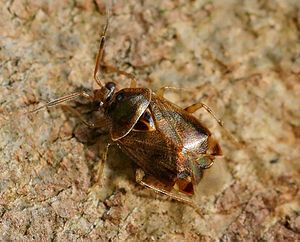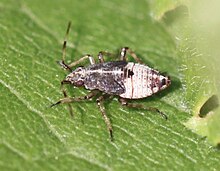Deraeocoris flavilinea
| Deraeocoris flavilinea | ||||||||||||
|---|---|---|---|---|---|---|---|---|---|---|---|---|

Deraeocoris flavilinea |
||||||||||||
| Systematics | ||||||||||||
|
||||||||||||
| Scientific name | ||||||||||||
| Deraeocoris flavilinea | ||||||||||||
| ( A. Costa , 1862) |
Deraeocoris flavilinea is a species of bug from the family of soft bugs (Miridae).
features
The bugs are 6.3 to 7.2 millimeters long. They have sexual dichroism . Males are much darker colored than the more orange colored females. The edge of the pronotum is finely pale in color. The cuneus of the hemielytras is variable in color, the sides of the scutellum are paler in color in both sexes. The rails ( tibia ) are ringed in white, which resembles Deraeocoris olivaceus , which also has a brick-red base color and thus resembles the females in particular. However, this similar species is larger and has long hair on either side of the pronotum.
Occurrence and habitat
The species is widespread in western and central Europe and in the western Mediterranean and was considered endemic to Italy a few years ago . In Germany it has only been known since the 1990s. It has now been proven here from the southwest to the north and northeast to Lower Saxony and Brandenburg. In Austria, the species has only recently been known and has been recorded in Vienna and Lower Austria. It also occurs in the British Isles, where it was first detected in 1996 and has now spread widely in the south and center. It can be frequent locally. In Central Europe it was initially limited to the settlement area, but has now also penetrated into habitats that are less influenced by humans. This could mean that humans were involved in the spread of the species.
Way of life
The bugs feed predatory, mainly on aphids, and live on various deciduous trees. They are mainly found on maples ( Acer ), but also on linden ( Tilia ), ash ( Fraxinus ), hazel ( Corylus ) and hawthorn ( Crataegus ), and more rarely on dwarf shrubs and herbaceous plants. The animals overwinter as an egg. The nymphs can be seen in May and June, the adult bedbugs in June and July, sometimes even in August.
supporting documents
Individual evidence
- ↑ a b c d e Ekkehard Wachmann , Albert Melber, Jürgen Deckert: Bugs. Volume 2: Cimicomorpha: Microphysidae (lichen bugs), Miridae (soft bugs) (= The animal world of Germany and the adjacent parts of the sea according to their characteristics and their way of life . 75th part). Goecke & Evers, Keltern 2006, ISBN 3-931374-57-2 , p. 37 f .
- ↑ a b Deraeocoris flavilinea. British Bugs, accessed January 3, 2015 .
literature
- Ekkehard Wachmann , Albert Melber, Jürgen Deckert: Bugs. Volume 2: Cimicomorpha: Microphysidae (lichen bugs), Miridae (soft bugs) (= The animal world of Germany and the adjacent parts of the sea according to their characteristics and their way of life . 75th part). Goecke & Evers, Keltern 2006, ISBN 3-931374-57-2 .
Web links
- Deraeocoris flavilinea in Fauna Europaea. Retrieved January 3, 2015
